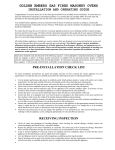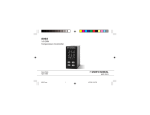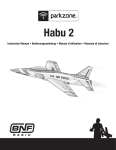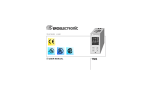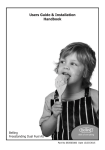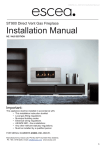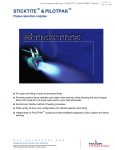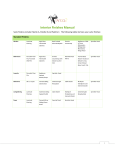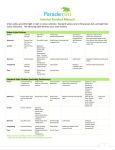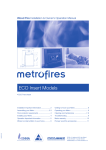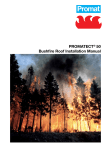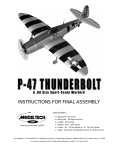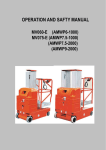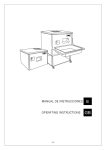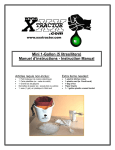Download Operating Summary - with AC11 Gas
Transcript
GOLDEN EMBERS WOOD FIRED OVENS INSTALLATION AND OPERATING GUIDE Congratulations! You have chosen one of the finest wood fired appliances available in the world today. To ensure that you enjoy the full benefit of using these extraordinary products, it is essential that you carefully follow all of the steps and procedures in this operating guide and seek the advice and assistance of your supplier wherever necessary. Your Golden Embers wood fired appliance has been constructed with the finest of refractory materials according to a technically advanced design based on thousands of years of history. With proper care and the minimum of maintenance, your appliance should last indefinitely. We realise that for many the use of wood fire appliances presents a new challenge and that a certain mystique has been attached to their usage. We believe that the information presented in this guide and the user manual will dispel any fears and misconceptions which you may have and enable you to rapidly convert your investment into the profitable centre piece of a successful eating establishment. All Golden Embers appliances, whether gas, wood or electric fired, are designed to give long and satisfactory service and have been fabricated from the best possible materials and workmanship. Nevertheless, proper selection, installation, adjustment and preventative maintenance is critically important if performance, efficiency and appearance are to be maintained for the life of the product. Please read all instructions carefully and seek explanations of anything you may be unsure of, as these instructions contain important safety information regarding the installation, use and maintenance of the appliance. ALL MATERIAL CONTAINED IN THIS DOCUMENT OR ANY OTHER DOCUMENT ISSUED BY GOLDEN EMBERS IS SUBJECT TO THE PROVISIONS OF INTERNATIONAL COPYRIGHT LAW AND MAY NOT BE REPRODUCED OR REPLICATED IN ANY WAY, WHETHER IN ORIGINAL FORM OR ANY MODIFIED FORM, WITHOUT THE PRIOR FORMAL WRITTEN CONESENT OF THE COPYRIGHT HOLDER. Instructions should be read and observed in the following sequence: 1) Any addendum or amended instructions as supplied with any upgrade or option. 2) Product specific instructions as supplied with the particular primary product 3) Quick reference operating guides supplied with the principal product 4) Component operating and instruction texts as may have been supplied 5) The Cooking with Fire Book and finally 6) any third party or additional texts. PRE-INSTALLATION CHECK LIST To ensure installation and delivery are quick and simple and that you have selected the correct appliance for your establishment it is important that you establish and confirm the following items prior to ordering and delivery. • • • • • • • • • Use the product performance data sheets to establish exactly which product model or variant will satisfy your volume requirements, having made suitable allowances for planned growth when estimating your requirements. Select the appropriate fuel type and source and ensure that there is a ready and reliable supply of that fuel. Check with your local authorities what if any approvals and planning permission’s may be required. Ensure that you have allowed sufficient space for the appliance to be correctly installed. Allow, if necessary, for any clearances from structures and adjacent appliances as may be stipulated by the local authorities. Ensure that there is an access point sufficiently large to allow for delivery and installation of the unit. Ensure that there is an adequate clear way from the point of unloading to the final position of set down and that the floor surface is able to bear the weight of the product during installation and positioning. Check that there is sufficient clearance through doors, and passageways and between other structures and appliances so as to be able to move the appliance to its set down position in the cooking area. Ensure that a dedicated flue can be installed in close proximity to the appliance or that appropriate measures have been taken to enable the flue to be safely connected to an existing extraction system. If a straight flue is to be installed, check that there are no beams or obstructions in the roof space above the appliance. Check the type and pressure of any gas supply if the appliance is to be operated on gas. This must be specified prior to ordering so that the appliance can be configured appropriately for safe and efficient operation. RECEIVING INSPECTION • • • • • Check all crates and packaging for handling damage. After checking for external damage, carefully remove the external packaging and check for any ‘concealed’ damage. Report any damage to the carrier immediately it is detected. The carrier may wish to inspect the damage. If gas or electrical appliance or back up systems are supplied, check the compliance plates to ensure that the correct appliance for the specified gas or power supply have been supplied. Care and diligence must be exercised when unpacking, assembling and moving the product. Special attention must be paid to fire hazards from combustible surfaces and the requirements of the local authorities and relevant safety or standards authorities must be complied with when positioning the appliance. INSTALLATION PROCEDURES • • • • • • • • • • • • • • • • • • • • • • • • Remove the base frame and assemble it. At the lower end of the front and rear frames place the cross members in the upper holes (110mm from the ground) so that a pallet trolley can fit under them. Leave the front top cross member of the frame so that the forklift can lower its tines. Remove the oven from the pallet by getting the fork under the front of the metal base and lifting the oven up several inches. It may be necessary to break the front board of the pallet away to achieve this Place two blocks of some sort (about 150mm thick) near the centre of the oven on each side to act as pivot points and lower the fork. The oven should now be balance some 150mm above the pallet. Place the tines of the fork under the steel base and lift the oven clear of the pallet. The tines should be set so as to be close enough to fit inside the frame and should not be inserted further back than about two inches in front of the temperature probe hole. Raise the oven to about 950mmm above the ground. Slide the frame under the base and slowly lower the oven so that the locating bolts pass through the matching holes in the top side members of the frame. Then fasten these bolts to the frame with the nuts and washers. Lower the tines of the forklift and fasten the top cross member of the front of the frame in position. Place the tines of the forklift, spread wide as possible, through the frame below the two top cross members. Now use the forklift to place the appliance inside the premises onto a stable level surface, whether this is through a doorway or through a window from which the pane of glass has been removed. If using the turning frame to achieve installation through standard 900mm doorways please carefully read and follow the instructions supplied separately with the turning frame. Either use the forklift to move the appliance to its set down position or place a pallet trolley under the frame and move the unit into position. At all times ensure that the appliance is only lifted enough to be clear of the floor excess height will result in the appliance being unstable during movement as it is top heavy. Once the appliance is in its final position remove the lower cross members and secure them at ground level or secure the side frames to the floor using dyna bolts and completely remove the front cross member. If gas back has been purchased, this should be fastened to the frame in the designated position. The exact fixing method depends on the class of burner purchased and is detailed in the accompanying instructions. Now connect any gas and power lines and test and commission any burners fitted. Your plumber or gas fitter should now fit any flues and exhaust ducts and adjust the damper settings. If a deluxe surround has been purchased this should now be laced around the frame and fastened to the locating ring around the girth of the appliance. If a turret surround has been purchased the upper portion should be fitted above the lower surround and fastened in position. To build the outer base enclosure, drop plumb line marks from the front corners of the tunnel and then draw a circle of the appropriate diameter on the floor, which passes through the two plumb points. Build a brick or other material base up to the level of the render of the oven. Take care at all times to ensure that there is no contact between the bricks and the steel base of the oven. Keep a gap of at least 10mm at all times. Then render the base (if desired) to line up with the dome in line with the top of the bricks. Cut a fine v joint in at the union between the top render and the base. This can be filled with polyfilla high stress or similar before painting or tiling. Finally insert the granite mantle and decorate to your own taste. Seal any joints and sponge the colour coating provided over the sealed joints so that they are not visible. Light the first fire or ignite the gas burner. Although Golden Embers appliances are pre-seasoned, it is still required that the heat up cycle be progressive. Initially heat the appliance to around 120oC and maintain that temperature for around 4 hours. Then raise the temperature in steps of 50 oC each four hours. Ensure that the gas flame (if any) does not fire directly into the oven wall and that the startup fire is kept in the centre of the appliance until a temperature of 300 oC has been reached FLUE INSTALLATION REQUIREMENTS • • • • • • • • • • • • • • • • • • • • • • • • • • • • All flues fitted to wood fired ovens must now comply with the Australian Standard for solid fuel burning appliances. Natural draft flues are more than adequate for most wood fire ovens and are the preferred method of extraction for Golden Embers Ovens and, in Australia, must be installed in accordance with the building regulations applicable to open fire places in the locality where the oven is installed as well as the solid fuel appliance code. In general, if a natural draft flue is not able to operate, you will find that there are other environmental airflow problems which will probable also cause combustion in the fire chamber to be inadequate. You must rectify these airflow problems rather than merely fix the extraction problem by fitting a fan forced unit. Smoke is generally only produced when lighting the fire. The fumes thereafter are not unpleasant and should not aggravate neighbours or statutory authorities. Because Golden Embers ovens use so very little timber compared to others, they will only produce negligible amounts of smoke at any time. Of course, burning green or wet or resinous woods will increase the amount of smoke generated by the fire. Where the fluing is to be directed into existing ducting or communal systems, it is important to ensure that these ducts do not have an excessive build up of fat. It will also be necessary to fit the oven with a spark-arresting device, such as Golden Embers Flame and Soot Filter modules so as to eliminate the possibility of sparks being carried into the flues and igniting any fatty deposits. A fire in the ducting or extraction system of any building can be disastrous. Because of this, wherever possible, provide a dedicated flue system for the wood fire oven. The ductwork can become extremely hot and should be insulated wherever it is possible for patrons or staff to touch exposed sections. This can either be achieved by installing insulated duct-work or after installation by coating ducts in a vermiculite cement or insulating fire rated material. The standard installation recommended is for the use of a vented twin skin flue, and, possibly a third (often-decorative) skin in the exposed areas. All flues must be twin skinned, with a stainless steel inner skin and a vented galvanised steel outer skin. The standard inner skin used is 8” (205mm) in diameter and the outer skin is 10” (254mm) in diameter. All penetrations through ceilings must be clear of combustible material and fitted with a non-combustible ceiling ring. The preferred cowl is a stainless steel wood fired appliance cowl with draft diverter. A directional wood fired cowl can also be used, if preferred. In some instances you may be required to fit an AGA gas cowl, although these decrease draw and will result in more rapid build up of wood burning by-products. The outer duct should be spaced from the inner duct by means of z spacers (or short sections of 1” square tube) at the top and bottom so as to ensure proper venting and continuous airflow. A notch should be cut out of the outer duct to allow the damper shaft to penetrate the outer duct. A quadrant, showing open and closed positions should be fastened over the shaft and fixed to the outer duct. If a third or decorative skin (copper or brass etc) is fitted then the quadrant should be fixed to the outside of this skin. If gas is being used then the damper blade must either be 5mm smaller in diameter or have a notch cut off each side so as to never allow the duct to be sealed. The outer duct must end about an inch or so lower than the inner duct and should be covered by a skirt cowl or weather spinning which does not seal it. Alternatively you can use a wood burning twin skin cowl incorporating the outer skirt. A 10mm high gap must be left at the foot of the second skin to allow airflow through the inter-skin gap. The inner skin must be fitted with a steel butterfly damper with a long shaft that penetrates the second skin. Don’t use aluminium cast dampers – they warp and fall out. Use fixed shaft steel or galvanised metal dampers only. The damper must be adjusted so that air is only just drawn into the flue. If the draw is too strong, heat will be drawn from the cooking chamber combustion will be excessive, wasting fuel and creating more soot. If gas is fitted then the damper must either be undersized or have cut-offs to prevent absolute closure of the flue. The damper shaft must be fitted with a lockable quadrant which shows open and closed positions. The roof penetration must be sealed with an appropriate approved aquaseal or deck-tite. The black type is generally adequate for twin skin flues, although the pink or red types are sometimes preferred by the AGA. A Golden Embers flue kit, containing all of the required elements for a straight flue to 4m is available for $325.00 additional straight sections are available for $50 per length of 900mm. (As at September 1998) Flues must clear the roof by at least 600mm and preferably 1200mm. The cowl must be at least 4m away from the nearest point higher than the outlet venting point. Where the flue protrudes more than 1200mm above the roofline, particularly in exposed weather situations, stay lines may be required to secure the flue and maintain rigidity and stability. Where the flue is in close proximity to timbers in the ceiling space etc, the flue has been wrapped in insulating blanket, either 25mm ceramic blanket (where the exposed timbers are highly flammable) or 50mm CSR Fibretex R350. Avoid bends and horizontal sections as far as possible and where they are absolutely necessary use 45 degree or lesser bends as opposed to ninety degree or sharper bends. Preferably use radius or lobster back bends as opposed to sharp bends. Where there is any significant extent of horizontal flue it is recommended that an inspection hatch be incorporated into the flue at the start ane end of any horizontal section to facilitate cleaning and maintenance. All bends and horizontal sections must be readily removable or fitted with inspection hatches and/or cleaning elbows. To minimise the risk of fire, it is recommended that the flues are cleaned at least annually, to remove any soot and other build up of flammable materials, although, in reality, you will find these to be negligible if the correct timbers are used. It is advisable to have the flue inspected after six months of operation to establish what degree of build up has occurred. Where there are any horizontal sections then it is required that the flues be inspected and cleaned more regularly. The design of the oven, tunnel and flue outlet is such as to make it near impossible for any sparks to enter the flue shaft during normal operation of the ovens. Nevertheless, where the flue is to be vented into a general or communal extraction • • • • • system, it is recommended that a stainless steel baffle element filter be incorporated into the transition flue inlet and that a break be incorporated into the flue at the point of coupling, effectively creating a miniature range hood. All flame is contained within the oven chamber and has to move out of the chamber at right angles to the induced convection flow, around a 45mm right-angled protruding lip. Thereafter, all flue gasses must move through the incoming fresh air stream, effectively inducing a vortex scrubbing effect, mix with an at least equal portion of fresh air, turn at right angles again and move into the horizontal section of the transition flue, once again change direction at right angles, before entering the flue shaft. Effectively this means all flue material moves through 320 degrees, around 4 bends, through one induced vortex and over two differing materials, before it entering the flue shaft. This design is far more effective at eliminating spark travel than the two horizontal offset strips used in competitive units (which vent directly from the cooking chamber), and which effectively put the air flue gasses through only two 45 degree bends. Should you wish to add additional filtration, then a twin baffle insert can easily be fitted from galvanised sheet and riveted into the transition, or, a stainless flame mesh filter can be fabricated to fit into the transition intake opening. If the flame filter insert is used, it will need to be cleaned extremely regularly so as not to obstruct the airflow. All flues must be professionally cleaned at least annually. Where bends or horizontal sections exist in the flue, or the flue vents into a common duct where fatty deposits may exist, it is recommended that they be cleaned six monthly and all bends should be fitted with inspection hatches The exact interval between cleaning for each specific system should be determined under advice of a professional flue cleaner or chimney sweep and will depend on many factors specific to the actual site and operating conditions and practices. IMPORTANT! - REFER AT ALL TIMES TO THE CODE APPLICABLE TO THE AUSTRALIAN STANDARDS FOR SOLID FULE BURNING APPLIANCE FLUES AND INSTALLATION. THE NATURE OF FIRE • Fire is due to a chemical process of oxidation, the combination of a substance with oxygen. Since fire is due to oxidation, it needs air to burn properly, and a flame will go out after it has used the available oxygen. Almost every material combines with oxygen given enough time. Iron, for example, will rust and the rust is oxidised iron. When the chemical combination occurs so rapidly that it is accompanied by a flame, it is called combustion. • The Ignition Point, or Kindling Temperature, is the degree of temperature at which a substance will catch fire and continue to burn. Substances, which can be ignited in the air, are called flammable. • The FlashPoint of a flammable item is lower than its ignition point. It is the temperature at which it gives off sufficient vapour to flash, or flame briefly, in air, but below the temperature at which it can burn continuously or spontaneously. • A fire, once started, will only be self-supporting when the temperature created by the combustion of the burning substance is as high as or higher than its ignition point. Some hard woods, such as ebony, require a great deal of heat to burn. If a stick of ebony is placed in a fire, it will burn. When it is removed the fire of the smouldering ebony itself has a lower temperature than the ignition point and the flames thus die. Fire can burn with or without flames. Flame indicates that heat has forced gas from a burning substance. The flame is produced by the combination of this gas with oxygen in the air. GOLDEN EMBERS WOOD FIRED OVENS QUICK REFERENCE OPERATING MANUAL (Refer to the detailed text of the product manuals and the Cooking with Fire book for more specific information) THE SELECTION OF FIRE WOOD CHARACTERISTICS OF WOOD • Wood is the hard, fibrous substance found beneath bark in the stems and branches of trees and shrubs. Practically all commercial wood comes from trees. It is plentiful and replaceable. • Wood is made up of a number of substances. Cellulose constitutes about 50 percent of the wood by weight. Lignin makes up about 23 to 33 percent of softwoods but only about 16 to 25 percent of hardwoods. • Ash-forming minerals are found in wood in very small quantities perhaps 0.1 to 3 percent by weight. Extractives are not part of the wood structure, but they contribute colour and odour to the wood. Tree fragrance is marked in some wood but essentially absent in many. • The classification of wood is related to the type of tree from which it is derived. Not all trees are used commercially. • Trees are divided into two large classes: softwoods and hardwoods. These names can be somewhat misleading, however, since there are hardwoods that are softer than some softwoods. Balsa, for example, is one of the softest and lightest woods, but is classified as hardwood, Even within tree species hardness and other wood properties vary, depending upon the conditions under which the tree was growing at the time the wood was formed. • The trees classified as softwoods have needle-like or scalelike leaves that, with a few exceptions, remain on the tree all through the year. Hence softwood trees are sometimes called evergreens. The hardwoods are broad-leaved trees and are frequently deciduous, shedding their leaves in winter. • Generally the wood nearest the bark of the tree, called sapwood, takes part in the life activity of the tree. The water, minerals and materials needed for growth are moved through the sapwood of the tree. The central part of the tree, which is usually darker, is called heartwood. Heartwood is denser and emits less smoke when burning, sapwood is lighter and burns more fiercely, but can be smoky, particularly if not properly dried and cured. • Each species of wood has its own characteristics, which will set it apart from other woods and to determine its suitability for certain uses. • Wood is made up of a number of substances. Cellulose constitutes about 50 percent of the wood by weight. Lignin makes up about 23 to 33 percent of softwoods but only about 16 to 25 percent of hardwoods. • The lignin binds the wood fibres together. Fibres with the lignin removed, called de-lignified fibres, are mostly cellulose. De-lignified fibres are used in papermaking. Lignin is an insoluble, intractable material that is difficult to remove from the wood. Hemicelluloses are associated with cellulose and make up about 15 to 30 percent of the wood by eight. Ashforming minerals are found in wood in very small quantities perhaps 0.1 to 3 percent by weight. Extractives are not part of the wood structure, but they contribute colour and odour to the wood. Tree fragrance is marked in some wood but essentially absent in many. Incense cedar and Port Oxford cedar, for example, have a spicy odour. Unseasoned oak typically has a sour odour. • • CHOOSING THE RIGHT FIRE-WOOD • • • You may use almost any species of hard or softwood (with the exception of pine and similar resinous timbers) to fire your oven. Ideally use a wood which gives a good flame and burns to ash. Certain timbers can be blended for their fragrance and aromatic flavouring properties. Very hard timber burns slowly with a smaller flame and yields large amounts of coals which smoulder for extended periods. Whilst these types of woods may well be the ideal woods for thermally inefficient ovens, they are not particularly suited to thermally efficient ovens, such as the Golden Embers ovens. This type of wood will inevitably cause excessive heating of the floor and a large amount of wood will need to be burned to obtain a good enough flame to heat the cooking chamber properly. Although it may seem contradictory, softer woods which burn more fiercely, such as wattle or sugar gum will be far more effective thermally efficient ovens with heat bank sub floors. ALWAYS use well dried timber cut into split logs no thicker than a man's forearm, and approximately 200 – 400mm in length. It will save a lot of time and effort it you get the timer merchant to split the timber for you. USING THE WOOD FIRE OVEN LIGHTING THE FIRE • During the first two days of operation it is important that the fire temperature be raised gradually so that all moisture can disperse from the oven walls without forming super heated steam. We recommend a rise of no more than 50oC per hour. • When lighting the fire at the start of the day use 5 - 7 logs depending on their size. It is safe to use low odour firelighters or a gas poker to start the fire; alternatively you can use the traditional kindling method. If you use newspaper or resinous timbers, such as pine, for kindling then it may be necessary to clean the flue more regularly. • You can either start the fire in its normal position at the side of the oven or you may prefer to start the fire in the centre of the oven floor and then move the coals and burning logs into position once the oven temperature has been reached. We have been unable to determine any specific advantage to either of these methods and so they remain an issue of personal preference, although the general heat dispersion achieved by lighting the fire in the centre of the oven would seem, in theory, to result in the most rapid heating cycle. • The oven should reach operating temperature after approximately 30 to 40 minutes. (Except during the first week or so of operation when excess moisture needs to be driven from the cooking chamber and the residual heat levels need to be built up in the sub base heat bank). MAINTAINING THE FIRE • The best fire position during operation is hard to one side of the oven. • A fire at the back may be more visible to the clientele, but loses much of the convection heat properties as the flames wrap around the chamber roof towards the tunnel and flue. A side fire results in optimum convection as the flames wrap from side to side across the oven chamber roof. In addition, adding wood to a rear fire will inevitable result in debris dropping onto the cooking floor (and food in the oven) as the wood passes across the entire oven from front to back. The fire should take up as little floor area as possible. Some operators use a simple metal or brick form to hold the fire in place. • It is very important to always have a good strong flame so as to ensure the cooking chamber temperature is properly maintained and the top of the pizzas are toasted. This will prevent the bases from burning before the top is cooked through. A single flaming log is usually adequate in the small oven and one or two in the large oven. Never cook with just coals!. Whenever the flame starts dying or the temperature starts to drop, put a new log onto the fire. Do not wait until the flames are completely out as this will mean that the new log will smoulder at first, absorbing heat and emitting smoke, rather than bursting into strong flame. • • Should you need to re-ignite your fire during the course of the day, paraffin firelighters may be used. Do NOT COOK ANYTHING in the oven till after the paraffin block is totally burnt out as this will result in the paraffin fumes impregnating the food. Alternatively, induce a flame by casting a handful of semolina flour or other combustible onto the glowing coals. • At the end of the day spread the coals over the cooking floor. This will burn off any residual food material and cleans and sterilises the floor. (See the section on cleaning the oven). • At night, seal the oven mouth using the door or aluminium foil to maximise heat retention until the next light up time. CONTROLLING THE FLOOR TEMPERATURE • It is very important to always monitor the temperature of your oven floor in relation to the rest of the oven. Should you find the floor is too hot and tends to burn the underside of your pizza base before the top is toasted, or the dough is cooked through, mop the floor with clean water to reduce the floor temperature. Use a standard “hairy” mop dipped in a bucket and then wrung out so as not to throw excessive amounts of water onto the oven floor. • Do not put cold water on the tiles as the thermal shock may crack them. Also do not dump cold water or a cold wet mop on the granite mantle as this will result in cracking of the mantle. CONTROLLING OVEN TEMPERATURE • If the oven temperature becomes to high simply use less wood, conversely add more wood if it drops too low. Applying a damp mop to the floor will result in a rapid fall in the air temperature as the water vaporises and absorbs heat. The oven is at the correct temperature when all soot has been burned off the surface of the dome and the entire inside of the dome is white. CARING FOR THE OVEN • • Every Golden Embers pizza oven has been designed to require minimal care and maintenance. For optimum performance observe the following basic “rules”: 1. Never throw cold water onto the oven floor or walls whilst hot. 2. Ensure that your smoke extraction system is kept clean and fully operational. 3. A small fire with a good flame is better than a large fire with many coals or many coals and a small flame. 4. Periodically check the flues to ensure there is no build up of grease, soot or foreign matter that could catch fire. • Exercise the normal level of care and respect that you would afford any other kitchen appliance. Avoid unnecessary impact with the interior oven walls and do not use sharp objects on the floor or walls of the chamber. • If roasting or grilling meats or similar items in the oven always do so over a drip tray. Because many of these types of foods are cooked at lower temperatures, the fats which they give off will not be vaporised, but will be absorbed into the floor bricks and will ultimately carbonise and turn black. Although this is not really dirty, (carbon is harmless and clean) it can look unsightly and patrons may feel the oven floor is dirty. • If you ever notice any cavities between the oven floor and walls, or any cracks in the oven walls, you should contact the supplier immediately. Heat “leaking” through these openings will reduce the efficiency of the oven and will cause further stresses on the structure of the oven. The supplier will normally be able to seal most such fissures very easily. • Always ensure that the bricks which make up the floor of the oven are level and replace any damaged, cracked or warped bricks immediately. CLEANING THE WOOD FIRE OVEN • One of the benefits of using a Golden Embers wood fired oven is the minimal effort required to keep it clean. • The best method of keeping the oven floor clean is as follows: 1. Once you have baked your last pizza of the day, spread the remaining coals evenly over the entire floor area, ensuring that as much of the floor as possible is covered in hot coals. 2. This will “burn” any residual matter from the floor overnight and will leave the floor clean and sterilised. 3. Prior to lighting the new fire use a hearth broom to sweep the ash out of the oven and dispose of it safely. 4. Mop the floor with clean water, using a natural type cotton mop that is fairly well wrung out. • Do not use any detergent/soap when cleaning the inside of the oven as any residue may impregnate the pizzas. • The interior walls of the oven dome should be kept clean by the natural action of the fire. If they do not appear to be clean, and the entire dome does not become white during cooking, the fire is not hot enough. If you normally run your oven at low temperatures it may be necessary to occasionally run a blazing fire to purge the dome. • During operation use the poker, fire shovel or fire tool to push any coals to the side. Sweep the ash to the side or back using the bristle broom. You can get bras or steel bristled brooms, however, these are not recommended as they can ‘pull’ the grout from between the floor tiles and any bristles which come loose can be picked up in a pizza and cause injury to your patrons or diners. For that reason we recommend bristle, coir or other natural fibre brushes, as any stray bristles will burn away. • The outside of the oven should be cleaned in accordance to the manufacturers recommendations dependant on which material you have chosen for the outer casing. In general periodic dusting or vacuuming will suffice. • It is equally important to ensure that the pizza making tools are kept clean and sterile. These should be treated no differently to any other kitchen utensil and should be kept hygienically clean at all times. BAKING IN THE WOOD FIRE OVEN • Your Golden Embers wood fired oven may be used to cook bake and grill almost anything. The unique design of the oven chamber results in a unique combination of grilling, baking infra red and convection type heat being created simultaneously. • When baking a pizza you may use either pre-baked pizza bases or raw dough. Raw dough is always preferable for taste and tradition whereas pre-baked bases are preferred for speed and convenience. Depending on the dough recipe and the quality of flour being used it is often desirable to par-bake your pizza bases. This removes the possibility of the base ever having raw dough in its centre, which often happens whey your oven temperature is either too high or too low, or the temperature balance between the floor and the chamber is not correct. • For purposes of efficient stock control, speedier customer service and quality control may operators have chosen par baked bases (done in house or bought in). A par baked pizza base will have a fridge life of 2 - 3 days and a freezer life of several weeks. • Several pizzas may be baked simultaneously in the Golden Embers pizza oven. As the oven heat is concentrated in he vicinity of the fire you should use the supplied pizza paddle to rotate the bases and ensure even baking. Alternatively you can fit the optional separator (or fire guard) which effectively separates the fire from the cooking area eliminating direct infra red exposure to the pizzas and thus minimising (or even eliminating) the need to rotate the pizzas during the baking process. • To rotate a pizza simply insert the pizza paddle under the corner of the pizza, twist the paddle so as to lift the pizza onto it’s opposite edge and using a gentle push/turning action rotate the pizza on the oven floor as if it were a wheel. With a little practice you will soon be an expert. • To avoid waste whilst you practice it is suggested you practice in an unlit oven with several pre-baked pizza bases until you are satisfied with your level of competence. The more competent you become with the pizza paddle the more pizzas you will be able to cook at any one time. For example, in the 1 metre oven a novice will easily manage 3 10 inch pizzas, a partially competent paddle user will manage 4 or 5 10 inch pizzas and someone very competent with the pizza paddle will easily cope with 6 or even 7 10 inch pizzas in the oven at once. GOLDEN EMBERS GAS SYSTEM INSTRUCTIONS: CLASS 1 - Fully Automatic - AC11 Series Golden Embers Gas Burner Systems are supplied as a pre-assembled kit and must only be connected to the gas main by a fully licensed gas fitter. All that is required to connect the kit is that it be positioned so that the top of the burner head is immediately (at least 15mm) below the underside of the oven floor, points directly up the centre of the burner tube hole and the burner bracket is properly secured to the frame or under floor plate of the oven base. The control box is a self contained unit and should be placed where convenient, providing the distance from the burner and temperature probe is such that the leads are all able to reach. The unit has been designed in cooperation with former AGA personnel to ensure compliance with AGA requirements as shipped and has been consistently 2nd tier approved as shipped.* It is the purchaser’s Responsibility to arrange or order Tier 2 or type B testing and approvals. To commission the system: 1) connect and purge a ¾” gas supply to the ball valve on the side of the burner system. 2) Plug in the 240v (or 110v) mains power lead into the power socket. – It is important to not that the system requires correct polarity and proper earth connection to function correctly. 3) Ensure that there are no leaks and light the system. (Initially it may take a while for the gas to clear the air from the lines - so you may need to try several times) *Golden Embers terms of supply excludes all testing or compliance procedures unless specifically designated / ordered. Once you get ignition of the pilot the pilot and main burner can be adjusted for optimum operation. Adjusting the pilot: The pilot used in these systems is pre-set to the correct levels for the appropriate gas type specified at the time of ordering. The Pilot injector module is predrilled and cannot be adjusted. If the pilot flame is not correctly sized then the gas supply pressure needs to be checked and rectified. Adjusting the air mix for the main burner: adjust the air mix for the main burner by screwing the adjusting ring up or down. There is a locking nut below this adjusting ring that should be used to lock the ring in the optimum position. The flame should be strong, clear and quiet. The flame in the oven should be as blue as possible. A yellow flame means that there is too little air, an orange flame means that there is too much air. A roaring flame means that there is too much air. A discoloured flame can also be a sign that there is debris in the burner tube or burner head. Adjusting flame size: If the flame size is too large or too small the gas flow can be adjusted by adjusting the regulator screw. The regulator screw is located under the large cover screw at the top of the control valve (see diagram 2) screwing it down will increase gas throughput while screwing it up will decrease gas throughput. Once you have adjusted it to the desired size you must securely replace the cover screw, which is sealed with an O-Ring. If the regulator is screwed down fully (fully open) and there is still inadequate flame, it means that the supply pressure is too low. Check that the supply line is not obstructed or damaged. If there is no obstruction then it will be necessary to remove the injector nozzle and increase the jet size by drilling out the injector hole. Do this in small increments (about .2mm) so as not to excessively enlarge the injector. Ideally you should drill it out until the flame is larger than desired and then reduce the flame by unscrewing the regulator screw. The injector as shipped is set for a gas consumption rate of around 50Mj/Hr during constant operation, which is normal for dual fuel systems. Procedures for operating: The first switch (black rotary switch on the side of the unit) is the master switch and will switch off the gas system and the temperature display module. Switch this switch on. The power on light will illuminate. The temperature display module will run a self test diagnostic for a few seconds and will then display the temperature in the oven. If you are not using gas and merely want to monitor the oven temperature, then this is the mode of operation to select. The second switch (the front panel rotary switch) is the gas system power switch. This switch will only operate once the temperature and master control switch is on. To activate the gas burner system, switch this switch on. Once the gas system is switched on, the safety circuitry will test the system for about 15 seconds. If the test is clear then the ignition system will start sparking at the pilot (short sharp crackling should be heard) and ignite the pilot flame. The Pilot On Lamp will illuminate once operating .If the pilot flame does not ignite properly within 20 seconds, the safety circuitry will lock the system and the flame failure lamp will glow. The system will not start again until the master switch is turned off and then on again. Once the reset lock out has been cleared the safety check, purge and ignition cycle will start again. When the temperature is below the preset temperature on the temperature controller the main burner will ignite and the main burner indicator light will be illuminated. Never place wood or other debris near or over the burner tube opening. Keep the fire at least 200mm away. Do NOT use the burner to light your firewood. Flame from the burner will assist in lighting wood at a distance. To switch off the system either switch of the gas circuitry first or disable the entire system by switching off the system master switch, or, to maintain temperature display but disable the gas system only, switch of the gas circuitry. To adjust the temperature: Press the set switch once, the set light will flash, now adjust the temperature up or down by using the up and down arrow keys. Once the desired temperature is set release the arrow keys and wait 15seconds. The light will stop flashing and the new setting will take effect. Trouble shooting: The flame is not crisp clear blue and quiet: - The air mix is not correctly set. Adjust it. The Temperature display is on and gas switch is on but the oven does not spark or ignite: The system has been locked out and needs to be reset. If the reset switch does not fix the problem call the supplier. If the reset switch is not illuminated and the system remains ‘locked’ then the switch globe must be replaced before operation can resume. The pilot flame lights and then the system switches off (erratically or consistently) - The mains polarity is reversed correct it at the power point or swap the active and neutral wires in the plug. The pilot flame lights, but ignition continues sparking and then the system locks out - The flame on the sensor side of the pilot light (white lead) is not burning over the flame rod properly. Increase the size of the pilot flame or reposition the sensor electrode probe wire. The main burner ignites but then ‘splutters’ and may even back-burn at the injector: - ash or debris has dropped into the burner tube. Immediately switch of the system and remove the mixer tube (the galvanised tube between the inspirator and burner head) and clean out the debris that is obstructing it and ensure that the injector and burner heads are properly cleaned. IF THIS HAPPENS IT MEANS THAT YOU ARE NOT OBSERVING PROPER SAFETY PRECAUTIONS WHEN OPERATING ON DUAL FUEL - REFER TO THE DO’S AND DON’TS LIST BELOW If there is no debris in the burner assembly, then - the Gas supply pressure is too low, call in you gas fitter and have the regulator settings, pressure and air mix adjusted so that proper combustion is once again attained. The flame varies in colour and clarity, or is erratic: There is debris on the burner head - see above. The system switches off when you place the cover in the tunnel mouth: Remember that you should never cover the oven entrance when burning wood, as you will extinguish the fire through oxygen starvation. You can cover the entrance if using gas only. If you cover the entrance and the gas system switches off, this means that the pilot flame is being ‘sucked up’ the burner tube by the airflow into the oven through the burner tube and is no longer reaching the flame detect sensor. To remedy this, move the pilot further back from the burner and/or increase the pilot flame size. The burner is properly adjusted but the oven temperature does not rise properly: The flue is excessively open. Adjust the damper as detailed in the operating manual. If it is necessary to have the flue too open to maintain draw then the air supply, make up air and extraction in the kitchen is not balanced and needs attention. IMPORTANT WARNINGS AND DO’S AND DON’TS Remember that all types of flammable gas can be extremely volatile and dangerous and that in the interest of your own and public safety, it is imperative that the system only be operated as instructed. NEVER light your fire over or near the gas burner. This will result in ash and debris falling into the burner tube and obstructing it. This can result in gas ‘leaking’ from below the burner tube and igniting (or even exploding) below the oven. You must always keep the fire cinders and ash at least 200mm away from the burner inlet in the oven. You must never operate the oven with both wood and gas unless the burner tube extension is securely fitted. To operate the oven with duel fuel in any manner other than as detailed herein shall immediately void your oven’s warranty and may result in the gas supply to your premises being cut off by the supply authority, or the burner being sealed by the supply authority or even in the imposition of fines by the supply authority. If you operate dual fuel ovens contrary to these instructions and a fire or explosion occurs and anyone is injured or killed, you may be guilty of a criminal offence and could be prosecuted and even imprisoned. Service calls to clear obstructed burner tubes are always chargeable and if recurrent will oblige us to notify the supply authority that a dangerous use situation exists at the premises in question. Never allow water to fall into or onto the burner system. This is an electronic system and must be kept dry. Always keep the housing covers on: The system is designed to be fire safe if the control box door is in place. If the door is removed then there is a risk of items under the oven being ignited by burning debris or back burning. Never replace the damper with one that fully seals or obstruct the flue. The emissions from gas burners can be toxic and it is a contravention of the law to obstruct the proper discharge of the flue gasses. If the unit is flued through a mechanical system and there is no natural venting if the fan is off, the gas system should be wired so as to operate only if the fan is on. Your burner is a precision system with integrated electronic safety features and must always be treated with respect and should only be used in absolute accordance with the manufacturers operating, care and maintenance instructions. To do otherwise will void your warranty and may be a breach of the law, and could be dangerous to the operators or public. GOLDEN EMBERS GAS BOOSTER KIT - PART NUMBER AC10 COMPONENTS LIST COMPONENT SUPPLIER White Rogers Control Combination Valve - Class 1 Brahma Automatic Ignitor System Part CM31F NG-40 40mm Burner Head by Australian Combustion Services 40mm Short Inspirator by Australian Combustion Services Campini CT3135 Thermostat Control – Digital Display Campini Type J self contained 150mm temp probe Brahma wind proof torch pilot assembly with flame rod and ignition rod 2.5m Type J thermocouple cable – Campini – Integrated Dormont tube interconnects – Flexible Stainless Steel Tube White Rogers – F92-0737 LP conversion kit 36c (only with LP system) Illuminated Indicator Lights – White Amber Green Red 150mm 40mm mixing tube - galvanised 40mm offset bracket for mounting burner tube Control Panel enclosure lockable and splash proofed 3 core 240V 10amp flex power lead (with 10 amp plug) 240V crimped female spade connectors - insulated Systems Control Systems Control Systems Control Systems Control. Systems Control Systems Control. Systems Control. Systems Control. Systems Control Systems Control Systems Control Systems Control Reece Plumbing Systems Control Systems Control Systems Control Number of Main Burners & Type: Maximum Gas Rate per Burner: Injector Nozzle Size as shipped: Combustion Rate at that size: Number of Pilot Burners & Type: Volume of Combustion Chamber: Flue Area : Type of Gas: Inlet pressure at main regulator: Outlet Pressure at last downstream regulator: Designed over pressure setting: Air Rate Purging Appliance: Which Fans Purge appliance: Air Rate at Ignition Regulator Breather vents: AGA No. 5256 5099 N/A N/A N/A N/A N/A N/A 5305 5256 N/A N/A N/A N/A N/A N/A Single NG Brown 40mm Long Pattern Inspirator 100MJ 2mm 60 MJ/hr Brahma Wind Proof Torch Burner Pilot – 5MJ/Hr 0.5m3 (Chamber volume excluding exhaust ducts) 0.034m2 LPG Unknown 1Kpa (Burner Pressure from valve regulator) N/A N/A Nil Atmospheric Incorporated in Approved valve Enclosures: Burner Tube: Bracket mounted below steel floor Optional Steel slide cover Box (Not ordered or supplied) Enclosures: Valve Control : Galvanised and enamelled single skin box Burner/Valve Fixing Method: Burner tube supported by stand off brackets fixed in position Fixed to steel frame and floor by bolts and/or rivets / welded. Enclosure Fixing Method: To be mounted by client at any convenient point, where connectors can still safely reach all appliance components (Valve and temp probe) GOLDEN EMBERS GAS BOOSTER KIT - PART NUMBER AC11 OPERATING INSTRUCTIONS: 1. 2. 3. 4. 5. 6. 7. Turn on gas main ball valve. Turn so that handle is in line with pipe to open. Switch on Main Switch on control panel to Power On Position – The power light illuminates Turn Switch to burner on position Automatic ignition cycle begins. If ignition sequence fails the flame failure light will illuminate and the system will lock out. If flame failure light is illuminated then switch the system off and on and cycle will restart automatically. Pilot indicator will illuminate once started and the main burner indicator will illuminate when operating SET THE OPERATING TEMPERATURE: 1. 2. 3. 4. 5. With the main switch on and the temperature display illuminated Press the set button once. The Out1 light will flash Adjust the temperature up or down by means of the up or down arrows Do not touch the buttons for 10 seconds. The new setting will be stored. To change the operating parameters - call your supplier or carefully follow the instructions in the detailed instruction sheet. Be aware that improper settings can have a significant impact on operation. TROUBLE SHOOTING SYMPTOM ACTION No sparking and switches do not illuminate. Check that mains lead is plugged in. Check that mains is on at wall socket. Check that circuit breaker on control box is not tripped. If tripped press back in. Check that there is power to that wall socket. If still not functioning then turn of gas ball valve and call your supplier. Try again, there may be air in the line, if still unsuccessful then check that ball valve is open and that the gas supply is functioning. If all checked then check that spark is going to pilot head, not to ground somewhere else. If still not functioning check cables to BM valve securely plugged in. If all these checks fail - shut ball valve and call your supplier Check that the flame rod (longer one) is in the pilot flame. If pilot flame does not reach the flow will need to be adjusted. If that side of pilot is not ignited (2 sides burning only) then the head needs cleaning or the airflow needs to be corrected. If all else fails switch off the gas at the ball valve and call your supplier. If you can hear or smell gas or there is a flame at any point other than at the burner head - shut down the gas supply immediately - the burner tube has been blocked by foreign matter and must be dismantled and cleaned Igniter sparks repeatedly, no pilot flame lights and reset light comes on. Pilot flame lights briefly then goes out and reset light comes on. Pilot Flame lights but main burner does not ignite If the burner “roars” and the flame originates in the burner tube and not at the burner head Any other abnormal behaviour of the system If there is no gas flow to the main valve - check that the temperature controller has been appropriately set. If everything appears correct then call your supplier. The air mix is incorrectly set. Adjust until you get a strong clear blue silent flame or shut off gas and call your supplier. Immediately shut the gas supply and call your supplier. The flame from the gas jet should be at least 10 to 12 inches long with natural gas, propane, LPG or butane. Basically increase the pressure until the temperature of the oven rises steadily in increments of around about 1 degree every 20 to 30 seconds once past the 150 mark.. If the damper is correctly adjusted, so that heat is just on the threshold of escaping from the tunnel mouth, but just not doing so, then the efficiency will be at a peak. To establish whether heat is escaping from the tunnel mouth with wood is relatively easy, simply close the flue down until smoke escapes and then open it just enough to eliminate the smoke leakage. With gas alone, hold your hand parallel to and just above the top of the tunnel mouth, rising heat indicates that the flue is too closed, open it until the rising heat just stops. If the flue is open too much temperature will be drawn from the oven and fuel consumption will be higher than necessary. Butane burns at a much higher temperature than natural gas. Ensure that the oven is fitted with an angled oven burner jet top so that the flame does not blast directly up into the oven wall. This will help to prevent undue heat stress of that portion of the oven wall, although fine cracking in the vicinity of the burner jet is often inevitable in any event. Although not essential, it is always recommended that at least 1 piece of timber be kept burning in the oven, even if it is merely a glowing log in the corner. This enhances flavours, gives greater visual appeal and will assist in ensuring that the oven floor is maintained at a constant temperature relative to the air temperature within the oven dome. To increase the gas pressure there is a regulator adjustment within the multi control valve block. It is located under the large silver screw at the top of the valve. Remove the large silver (5c piece sized) screw and open the pressure by adjusting the little brass screw at the bottom of the shaft. Having adjusted the pressure there, you may need to adjust the air/gas mix so as to maintain a clear, quiet blue flame. If the pressure cannot be raised sufficiently at that point, you may need to adjust the supply pressure at the in-line regulator in the supply line. Remember that the valve operates optimally at a maximum of 5.5 pressure. If pressure is adjusted to optimum and the temperature is still inadequate, then it may be necessary to increase the size of the injector size. This is done by simply removing (unscrewing) the brass injector nipple and drilling the injector out. Increase the size in 0.2mm to 0.5mm increments until the required flame size is achieved. GOLDEN EMBERS AC11 CLASS 1 GAS/WOOD FIRE GAS TRAIN SCHEMATIC AND LEGEND GOLDEN EMBERS Stucco Oven Installation Specifications The cooking chamber of the oven is a single piece casting. The cooking chambers are cast from high performance retrorefractive refractory clay and mineral compounds, rich in alumina, magnesium and silica, and are designed to far exceed the temperature and performance requirements of the Ovens under any anticipated operating conditions. Compound Formula: Si02 Al2O3 Fe2O3 TiO2 CaO+MgO Na2+K2O,Zi, Service Temp: =1,650 oC continuous 2,635 oC Peak,Mass Required=2,530Kg/m3,Bulk Density=2.5g/cm3,Cold Crushing Strength>=70 mpa, Thermal Conductivity=0.75W/mK, Permanent Linear Change Characteristic (after 2hrs@1550oC)<0.4% The weight of the ready to install oven is approximately 930Kg (PZ10) or 1450Kg (PZ12) or 1790Kg (PZ14) The Ovens have a continuous service temperature rating of >= 1,650° C and a peak rating of 2,635° C The cold crushing strength of the Mineral clay compound as cast is in excess of 40 mpa (increases with curing) Thermal conductivity is rated at better than 0.75 W/Mk and linear expansion (2Hrs at 1,550°C) is <0.4% Each PZ10 oven has a diameter of <=1350mm (external) and 1005mm (internal). Each PZ12 oven has a diameter of <=1650mm (external) and 1225mm (internal). Each PZ14 oven has a diameter of <=1650mm (external) and 1225mm (internal). The cooking chamber has been thermally engineered to maximise heat dispersion and thermal efficiency and minimise fuel consumption. Heat up times from fire lighting to fully operational is less than approximately 30 minutes. Wood usage is minimised - in an average week of 80 hours operation (depending on species) - less than 120kg for the PZ10 and less than 180kg for the PZ15 Where gas combustion is fitted the burner is set to combust 25MJ/Hr for duel fuel and 45MJ/Hr for gas only at maximum and during intermittent operation only. Each cooking chamber is guaranteed not to crack during normal use. The dome, insulating and decorative skin is multi layered, being: 90mm High Alumina, High density, High Purity, Low cement, Continuous pour Refractory Castable 25mm High density Zirconia Blanket (160Kg/m3) 25mm High Density Ceramic Blanket (130 Kg/m3) 25mm Fibretex 350 or Fibremesh 650 (multiple layers in some areas for shape) Galvanised mesh 25mm or greater 90% Vermiculite based Insulating Render Alumina Fondue render Colour Hardener skin or acrylic coloured render The base is constructed from 6mm thick preformed strengthened and reinforced high density high carbon steel plate surrounded by 1.6mm steel sides welded to the base plate to a height of 210mm. The Base is insulated with 35mm of a vermiculite based insulating mortar, filled with compacted pure silica sands where each grain is 50 microns in diameter, then topped with copper gauze, a thin conductive refractory skin and super heavy duty high purity 25mm or 38mm (~50% Alumina) refractory bricks grouted with refractory castable and mouldable zirconia insulation. The base frame is constructed from 50mm x 50mm x 6mm carbon rich black high strength structural steel. Welded and bolted and treated with a rust inhibiting epoxy coating. A gas burner tube and temperature probe tube is integrated into every floor for immediate use or easy upgrade. The external temperature of the unit installed as specified is zero-rated. MORE DETAILED SPECIFICATIONS ARE AVAILABLE ON COMPLETION OF THE COMPANY'S NON DISCLOSURE AND SECRECY AGREEMENTS. COPYRIGHT AND INTERNATIONAL TRADEMARKS AND PATENTS PROTECT ALL CONCEPTS, DESIGNS AND PROCESSES. INFORMATIONS PROVIDED HEREIN IS MERELY AS A SALES TOOL AND DOES NOT CEDE, SURRENDER OR RELINQUISH ANY OF THE RIGHTS HEREINBEFORE DEFINED. ALL RIGHTS ARE RESERVED. BREACHES WILL BE PROSECUTED TO THE FULLEST EXTENT OF THE LAW CM12 U MICROFLAT B1154x • Restart attempt • Plug in electrical connections • Pilot / Main Gas (2 valve) • Non Volatile lock-out • Pre-purge 1.5 seconds • Flame failure safety time - 5 or 10 seconds • Ionization flame electrode control • 240 or 110 volt AC AGA Approval Number: 5391 Class 2Cb Brand Name: BRAHMA Category: Burner Controls/ Flame Safeguards / Flame Detectors - UV> Burner Control with Integral Ignition HTX CP3135 • 1 Set-point • Range 0-450oC • Alarm output • Accurate to 1% • "J" type thermocouple (0-450oC) Brand Name: CAMPINI Category: Thermostats / Temperature Indicators / Thermometer> Thermostat> Programmable



















